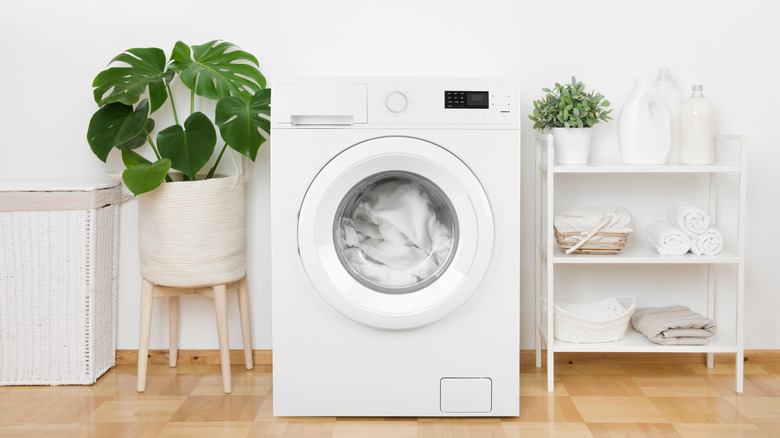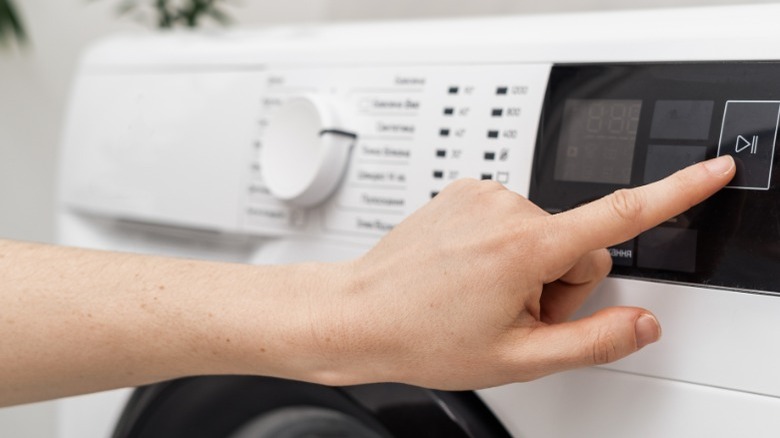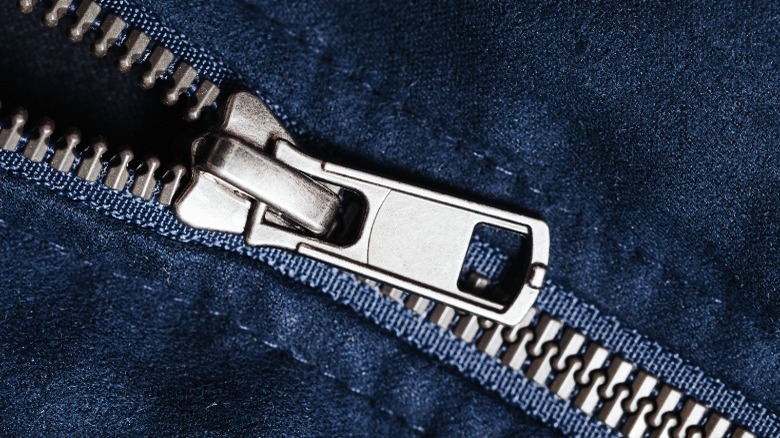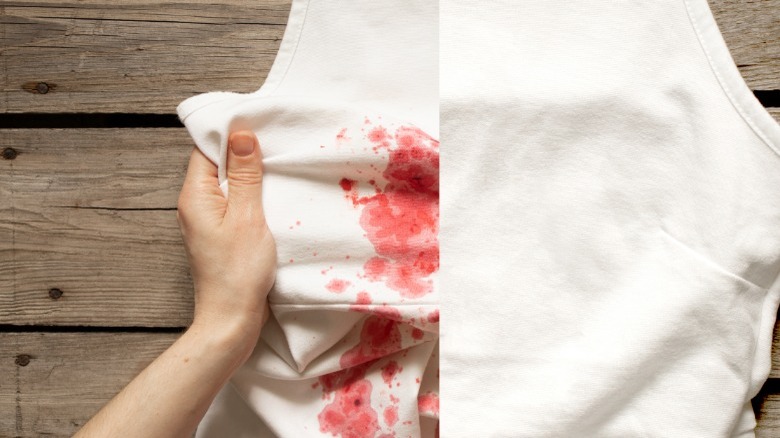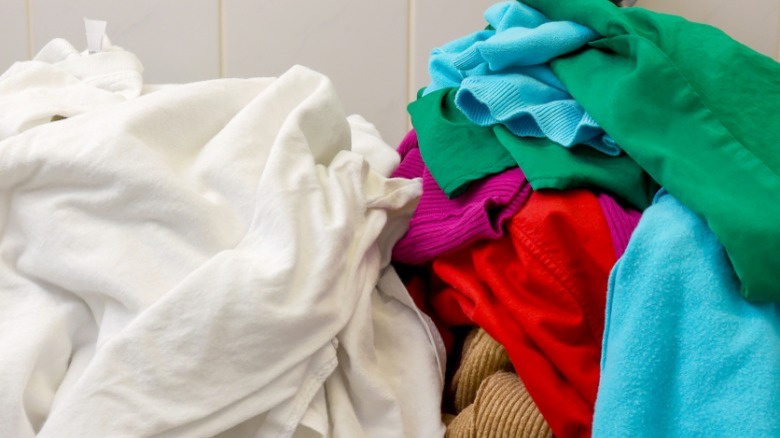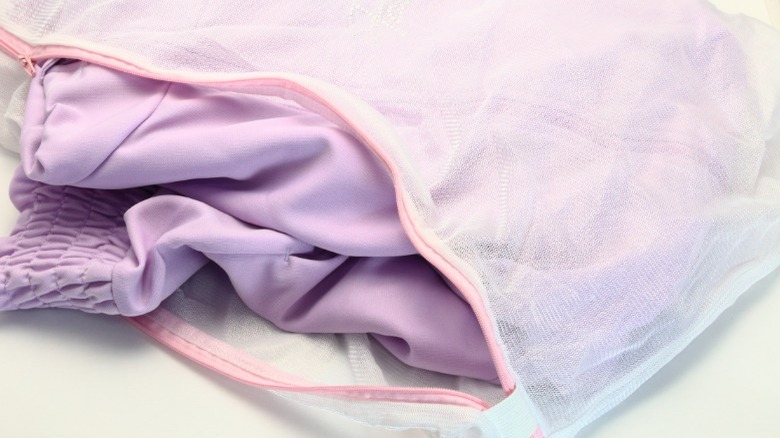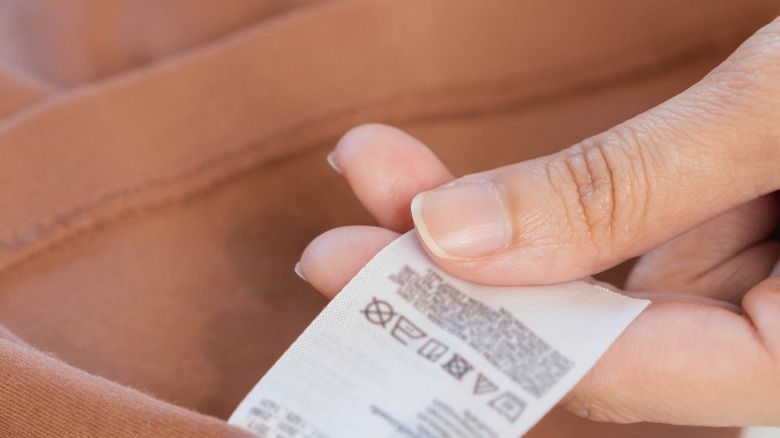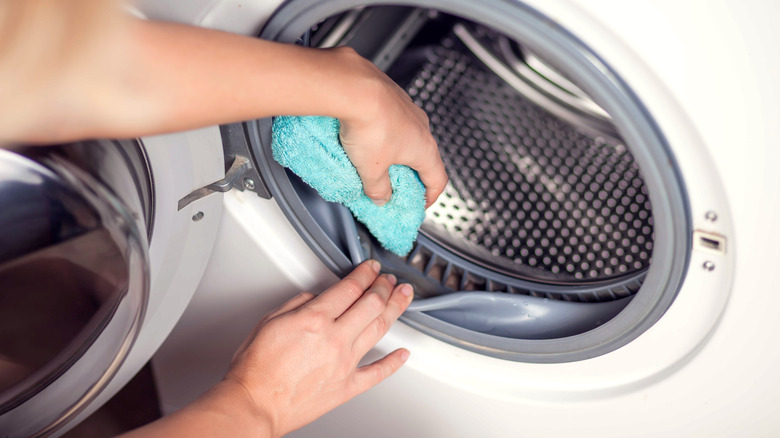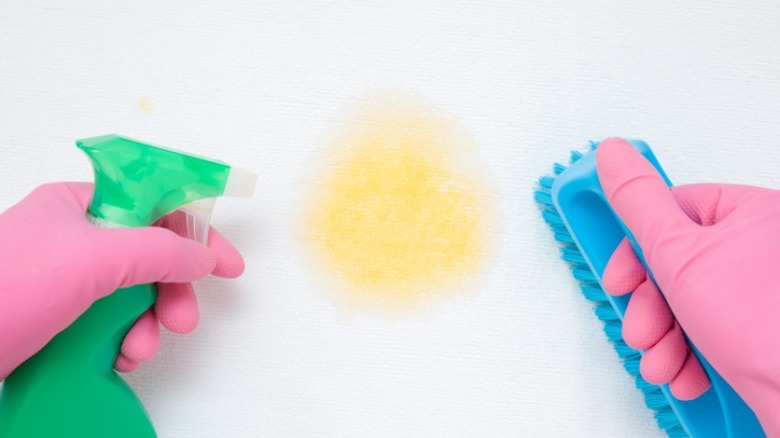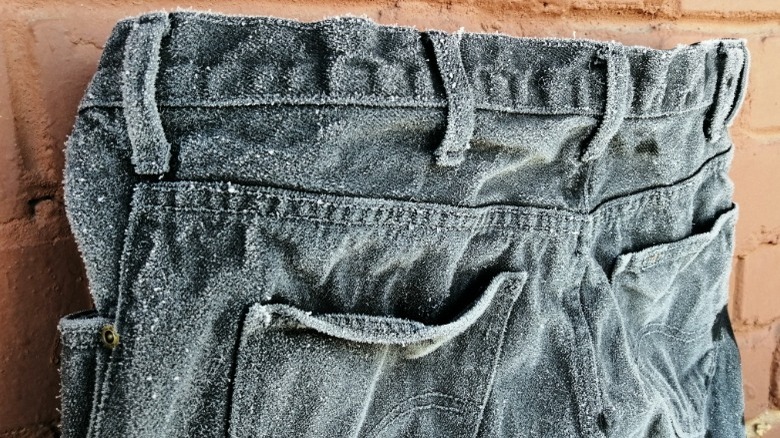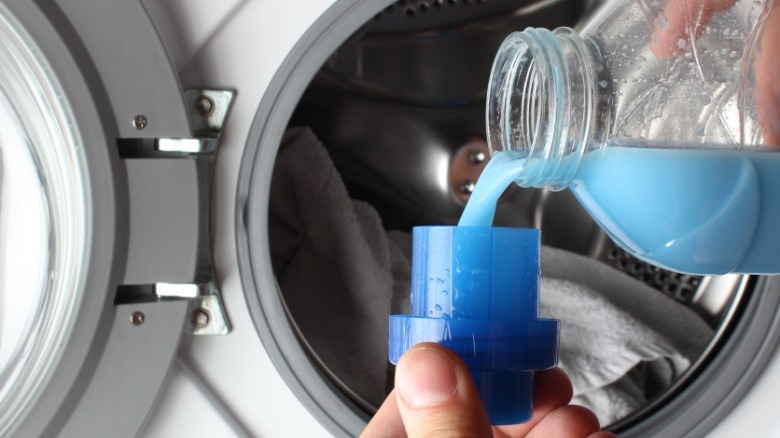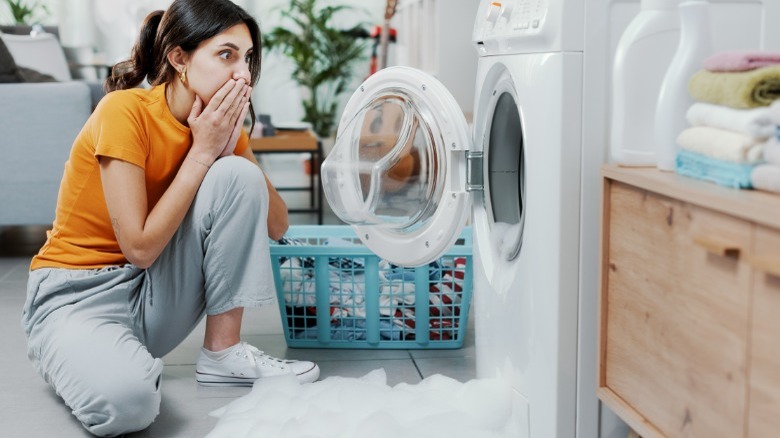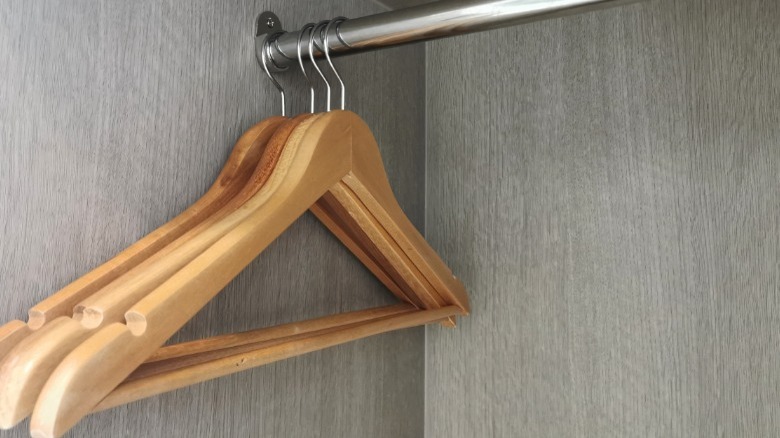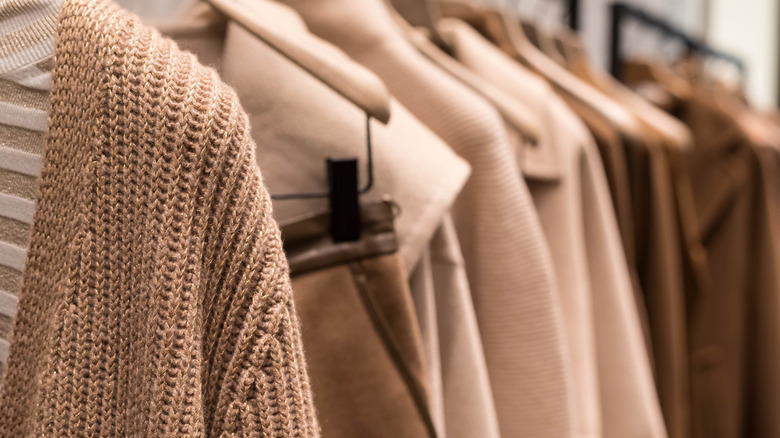Stop Believing These Laundry Myths That Are Damaging Your Clothes
Clothes are more expensive than ever, so you'll want to do everything you can to avoid damaging them. And even though some clothing is of lesser quality, anything in your hamper can get ruined slowly over time when the wrong techniques are used. Besides the obvious shrunken sweater, damage includes stains embedded into the fabric, colors running onto other fabrics, and misshapen garments.
Old habits aren't always the right ones, even if your parents taught them to you. They may have stressed using the hottest water possible and putting all clothes into hampers after being worn once. Sorry, Mom and Dad, but some of these methods are just myths. Below, laundry fiction is separated from fact, and once you change up the routines, your clothes will look better and last longer. Laundry day still won't be exciting, but at least it won't be such an exercise in frustration.
You must use hot water to clean all clothes
Water must be boiled to kill bacteria and viruses, but not all clothes need to be disinfected. Things like towels, sheets, and socks might, but you probably don't need to sanitize sweaters or sweatpants. A simple wash will suffice. Hot water is particularly damaging for delicate fabrics like lace and wool because it can make them shrink, become misshapen, and discolor. Hot water can also ruin synthetic materials like nylon and polyester, and bright colors will fade.
Today's high-efficiency washing machines are designed to perform well with warm, cool, and cold water, meaning they'll clean your clothes efficiently no matter the temperature. Modern detergents also work well with cooler water, so you might not need to use the hot cycle at all unless the fabric care label specifies that you should. Hot or warm water is better to presoak clothing stained with oil, sweat, dirt, dyes, and tomato-based products, and you can do that in a sink for a couple of minutes. But if the stains are from chocolate, blood, urine, and dairy products, cold water will be fine.
Zippers don't need to be zipped
Zippers can be finicky when they're not treated right. If you force a stuck one, push it down too far, or forget to close it up before laundering, it can stop working. And no one likes to struggle with a jacket, pair of pants, or shirt because of a jammed zipper. Closing them shields the teeth from damage when laundering. Besides that, an open zipper can snag on your other clothes, and the teeth can scratch the insides of your laundry machines.
As a side note, don't dry clothes with zippers on high heat, and remember to remove them quickly after the cycle because the metal tends to heat up. Straighten them out to keep the zipper from getting misshapen, and if it breaks, you may be able to fix it with a zipper repair kit. Replacing one might be worth the investment with expensive or favorite pieces of clothing.
Blood stains never come out
Blood stains are notoriously hard to remove because the same coagulating agents that form scabs also bond blood to fabrics. But even Dracula will tell you that it is possible to get them out. So don't throw out your favorite garment if a little bit of cold water doesn't remove those dark marks, because there are a few ways to do it. And the chances for success are better with fresh blood stains.
The first method uses cold water and a bit of dish soap. Start by dipping a clean cloth into this mixture and gently dab it on the stain. You can also add a few tablespoons of hydrogen peroxide, too. Thicker, dried-on blood stains can be scraped out into a sink before dabbing. If the marks come out, launder as usual. Vinegar can also remove blood stains but needs to sit on them for 10 minutes to work. Another DIY method is to make a paste out of baking soda, salt, and water, which gets rubbed into the stain.
Laundry only has to be sorted by color
If you've ever had a white shirt turn pink because you washed it with red pants, you have learned the importance of sorting laundry to prevent colors from bleeding. But that's not all, because mixing fabric types and weights in laundry loads damage clothes.
To protect your clothes, remove heavily soiled laundry and wash them separately. The grease, dirt, and odors could transfer onto other items, and the washing machine needs more agitating power to do the job. Clothes must also be sorted by fabric weight. Washing lingerie and towels together can damage lighter items. And besides that, heavier things take longer to dry. Your favorite negligee could get overdried, and your bath towels might still be damp when the cycles are complete. Keep a few hampers in your house and wait until each sorted group is enough for a full load. You can also handwash your delicate items and hang them to dry if there aren't too many of them.
Clothes must be washed each time after they're worn
If you feel like you live in your laundry room, you might be washing your clothes more often than needed. Of course, certain things should be cleaned after one day, but others will be fine if you wait. Underwear, bras, socks, t-shirts, and camisoles should be tossed in the hamper after one wearing since they are closer to the body. These serve as barriers for things like pants and dress shirts, which can be laundered after being worn twice or thrice.
Bathing suits should also be washed after one time, as should tights and thin leggings. Those last two can develop baggy knees, even when they're clean. Jean and PJs can take three wearings; formal wear like dresses and suits can often go even longer. It also depends on how much one sweats and if there are smells and stains, so these are just guidelines.
Lingerie must always be hand washed
Hand-washing lingerie is usually a safe move because of the delicate materials, hooks, and other closures. But you don't always have to do this, especially when your washing machine has a delicate cycle. And for added protection, you can place these items in mesh fabric bags. These are sold in sets of various sizes, with zippers to hold everything inside.
Place the delicate items in the bag, zip them up, and wash them on a cool or cold delicate cycle. You can use a laundry product designed for this, like Woolite. But never put delicate lingerie in the dryer since the heat can damage them. Instead, gently press out the excess water and lay them flat on towels or hang them to dry. If they feel a bit stiff, put them back inside the mesh bags and toss them in the dryer. Run the air dry cycle for 10 minutes, and your lingerie should be nice and soft.
Fabric care labels aren't important
If you ignored the fabric care label on your beloved cashmere sweater and machine-washed it in hot water, there's no one to blame but yourself. While it's true that some garments marked "dry clean" can be successfully washed in cold water, why take a chance?
Today's fabric labels often consist of several attached labels in different languages, so it can be time-consuming to figure out the instructions. The small print doesn't help, either. That's why it's helpful to understand what those little symbols mean. There are a few basic international ones that you'll see the most often. The one that looks like a washtub with water means the garment can be put in the machine. There may be an optimum wash temperature or dots shown as well. A square with a circle inside means the item can go in the dryer, and an iron is self-explanatory. A triangle signifies bleach, and a circle stands for dry cleaning. An X over any of these means that you should avoid doing it. Some clothing, especially more delicate ones, have more detailed fabric care labels.
Homemade dryer sheets don't work
Dryer sheets make clothing feel and smell wonderful but can be pricey because they are only used once. DIY-ers rave about homemade dryer sheets, yet many don't believe they work. Making them requires a bit more effort, but you'll be impressed with their effectiveness and sustainability.
All DIY dryer sheets are made with clean, cut-up dish towels or old clothing. The first method soaks those in about 1 cup of fabric softener and allows them to dry. Another uses a jar with a tight-fitting, non-metallic lid because that could rust. Fill the jar with white vinegar and a few drops of your favorite essential oil, and add your cut-up material. You can also use 1 part vinegar and 3 parts hair conditioner. These sheets can be squeezed out after you shake up the jar. Wash your dryer sheets with another load of laundry after using them, and soak them for the next time. They cost a few cents apiece and also prevent the dreaded static cling.
Laundry machines clean themselves
Don't feel guilty if you think washing machines never need to be cleaned because this is yet another disproven laundry myth. It makes sense that all that detergent and water would also clean the working parts, but the dirt and bacteria in the fabrics get into the machine. This can cause mildew, fungus, and, to put it bluntly, nasty accumulations of crud.
Fortunately, cleaning a washing machine takes little effort. Simply fill the detergent hopper with 2 cups of white vinegar or 1/2 a cup of bleach and run a hot water cycle. Then, run one more complete cycle to remove the residue on the inside. If you use the washer often, you can do this once every week or so. Otherwise, once a month is fine. And remember to wipe off the exterior once in a while, too. As for your dryer, remove your lint screen and clean it off before each load. This quick maintenance trick is important because the lint can clog up the dryer hose and create a fire hazard.
Use elbow grease when scrubbing stains
Why do people try to remove clothing stains with scrub brushes? Probably because they think more effort is needed. However, it is a mistake that damages clothes. Rubbing and scrubbing stains can expand further into the fabric, creating larger stains. And on top of that, the heat you're generating can make them penetrate deeper into the fabric. That can make it a permanent stain and might also damage the material.
So instead of scrubbing away, apply a stain remover product onto it and blot with a damp sponge, cloth, or paper towel. If this doesn't work, try using a paste made from baking soda and warm water. A vinegar soak can also work on tough stains. After pretreating, wash it according to the manufacturer's label but keep it out of the dryer. Let it air dry, check carefully for stain residue, and treat again if needed.
Freezing jeans kills bacteria
This is an interesting myth, but it is not recommended. Jeans are heavy when wet and can shrink in the dryer, so perhaps this myth originated as a time- and energy-saving hack to harden them up while killing bacteria and odors. But a pair of jeans can take up valuable freezer space, and there is no scientific proof that freezing does anything besides make them cold and rigid.
The right way to wash new jeans is to do it separately from other clothes because they tend to bleed. And always flip them inside out before putting them in the washer on a cold water cycle. They can usually go in the dryer, but check the label first. To make jeans last longer, remove them from the heat while they are still damp. Turn them right side out, and either hang them up or lay them flat to dry.
Fabric softener can be used on all clothes
Clothes, towels, and sheets feel so nice against the skin when they're soft, but fabric softeners are not recommended for certain types of clothes. It should never be used on moisture-wicking fabrics because it leaves a residue that can block the wicking action. The label might not indicate this, either. Workout clothes that keep you cool and dry when you get your heart rate up are often made from these materials. And if you regularly add softeners when washing them, you'll start noticing that your workout clothes aren't working for you.
Fabric softeners create wax-like coatings that can damage other fabrics too, and some might even produce allergic reactions. Dryer sheets made with fabric softeners can do the same thing. However, if you want to make the fabrics feel better, that DIY vinegar and essential oil fabric sheet might be the safest answer.
Extra detergent makes clothes cleaner
Those fill lines on washing machine detergent dispensers and laundry detergent caps exist for a reason. Only a certain amount of product is needed to thoroughly clean your items. Adding more for extra cleaning power might seem logical, but this is a myth. And since today's laundry detergents are more concentrated than in the past, going over the line can damage your clothes and affect the efficiency of your machine. You can help the detergent work harder by adding some distilled white vinegar to the load instead.
What happens when extra detergent is added? The soap-to-water ratio increases, the detergent doesn't get completely rinsed out, and the clothing can have a light coating of soapy residue. You'll feel it when you wear them and will probably have to run an extra rinse cycle. The clothing won't last as long, plus you'll be wasting detergent. Instead, follow the machine or detergent fill instructions for the best results.
Longer drying times are more effective
If you think it's okay to dry clothes on high heat and do it often, your clothes are being damaged. Those temperatures damage fabrics; two of the most obvious signs are melted or warped elastic and shrinkage. This isn't only when you use high heat to dry new clothing for the first time. Older clothes will continually shrink each time, getting smaller and smaller.
High-heat dryer cycles can be fine for heavy items like towels, sheets, and pillowcases, but not clothes. Always use a medium or low heat setting, but try the latter first since it's less invasive. If the clothes aren't dry enough after one cycle, you can do a second, short cycle at the same temperature or air-dry them. You can also air-dry heavier items overnight and run shorter, lower heat cycles the next day. This way, the heat won't have to run as long.
All tops and bottoms can be put on hangers
If your sweaters look stretched out and your dresses are droopy, the likely culprit is hangers. While it's fine to hang up many kinds of clothing, the heaviness of weightier fabrics and gravity drag certain ones down and damage them. Lay heavier clothes flat on towels and flip them over when the tops are dry. Then, they can be neatly folded and stored on shelves and hangers.
Jeans can be hung up even though they're heavy because denim isn't as stretchy as other fabrics. But hang them upside down by the hems on hangers fitted with clamps when they're still a bit damp. That way, the length will stay the same. Fold them neatly afterward if desired. And be careful with the types of hangers you use, because many leave indentations or bumps on shirt shoulders or arms. Look for ones with velvety coverings because these don't leave marks.
Clothes don't have to be cleaned before they get stored away
Storing away out-of-season clothes creates valuable closet space, but if you don't wash them first, you may be in for some unpleasant surprises when you take them out. If you see an armpit stain that wasn't noticed when you put that shirt away, it might be impossible to get out. The chances for stain removal are stronger when done at the earliest opportunity. There could also be residual odors like sweat and trace smells from that barbecue restaurant you visited last spring.
Another reason to wash clothes before storing them is unwanted pests. Bugs and moths are attracted to bacteria, and you might be crestfallen to find holes in that expensive wool sweater. Or, if you were out in the snow, your winter jacket and pant hems could have salt stains. You might not need to clean an entire season's worth of clothes before storing them, but things worn at least once must go into the hamper.
